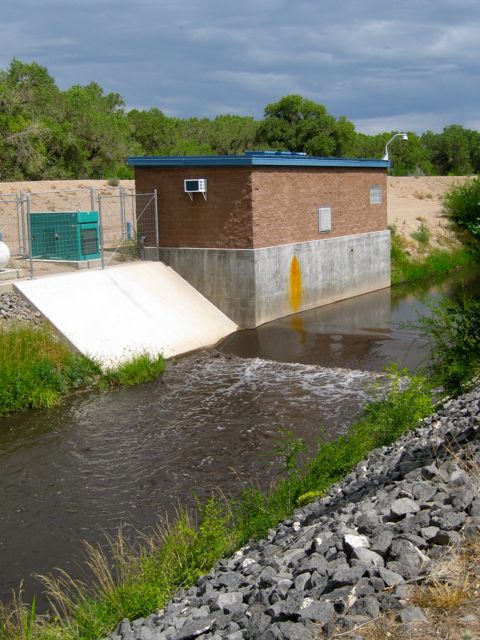I tried my best while I was out riding this morning to get a picture that shows the strange discomfort flowing past in the Rio Grande and the irrigation ditches that flank the river as it passes through town. Need words to help – the water at this spot, on one of the ditches in Albuquerque’s south valley, is usually clear. It’s a spot where I often see a black-crown night heron fishing. Today, it was gunk.
The Las Conchas fire, which goes down as the “largest fire in New Mexico history” (more on the scare quotes later) was reported 99 percent contained this morning, meaning we’re almost done with it as fire. But it is monsoon season here, when fire’s aftermath turns to ash and mud and debris flows. As I wrote in Saturday’s paper (sub/ad req):
The runoff marks the latest wave of problems from one of the worst fire seasons in New Mexico history. While the fires and the damage they directly cause have drawn the most attention, experts say watershed damage is one of the biggest threats they pose in the long term.
Santa Fe and Albuquerque both shut down their drinking water river diversions. Albuquerque shifted to groundwater. Santa Fe has been forced to draw down reservoirs that were already perilously low because of the pitiful winter snowpack.
I wrote a piece a couple of weeks ago about the “new normal” as increasingly unhealthy forests and a changing climate create conditions that are ripe for this sort of fire year:
We are living in what some scientists have taken to calling the “Anthropocene,” a geologic era during which human influence dominates the landscape around us in ways that will be easily detectable long after we are gone. In the woods above Los Alamos, a big part of that influence dates to the arrival of the Chile Line trains in the late 1800s and the expansion of grazing animals that accompanied it.
“They ate all the grass,” McDowell said.
That grass provided the fuel for frequent, low-intensity surface fires that cleared out undergrowth while leaving the forest’s great Ponderosa pines intact.
Well-intentioned and effective but ultimately counter-productive efforts to snuff out every fire before it could spread added to the problems that finally blew up in the mountains bordering Los Alamos and Santa Clara Pueblo in the last two-plus weeks.
But I feel like I’m only scratching the surface. I didn’t touch the issue of water and watersheds in the “new normal” piece, and I’m only beginning to understand the forest health issues that are driving all of this.
Albuquerque’s Rio Grande drinking water system is back up as of Friday, and Santa Fe hopes to get going next week, two more steps toward an uncomfortable normalcy.

